LifeFone Medical Alert System Review
A Lightweight, All-In-One Medical Alert Device with Outstanding Battery Life
SafeHome.org may receive compensation from some providers listed on this page. Learn More
We may receive compensation from some providers listed on this page. Learn More
A Lightweight, All-In-One Medical Alert Device with Outstanding Battery Life
Struggling to convince a loved one of the value in using a medical alert device? On their website, LifeFone offers a few suggested comments.
This one especially grabbed us: “LifeFone is like insurance, you may not use it today, but if you need it, you’ll be glad you have it!”1
Great point! But why LifeFone and not another medical alert system?
During the several days that we lived with one of LifeFone’s At-Home and On-the-Go systems, we learned a few things about the brand that distinguishes it from other systems.
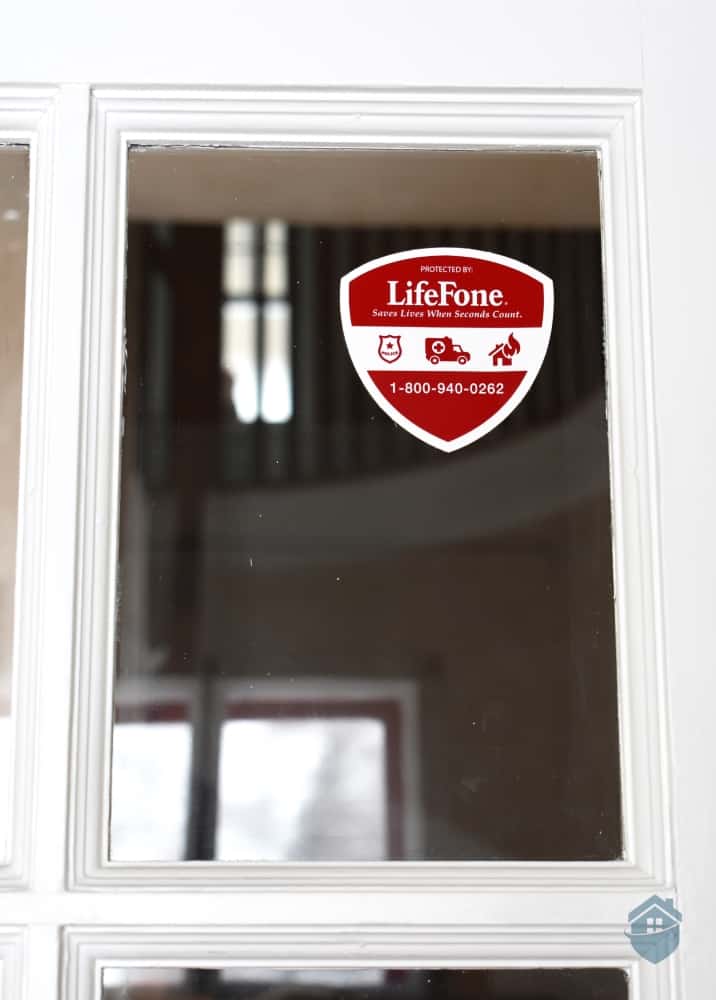
LifeFone Sticker
Overall, we found the quality of LifeFone products to be excellent. The unit we tested offered up to 30 days of battery life, and each of the six systems available can be upgraded to include fall detection.
In addition, founded in 1976, the company has used its time in the market to learn what customers want in terms of packages and deals. In fact, LifeFone offers many different ways to save money on emergency medical alert coverage.
Of course, it’s not without its downsides, especially in the pricing department. LifeFone’s monthly fees are slightly more expensive than the industry average, particularly if you choose one of the more advanced systems.
FYI: While LifeFone’s product is relatively simple, their sales pitch is somewhat complicated. Was it a dealbreaker for us? No, not at all. And while we did hit a couple of snags while using LifeFone, we found that these alert systems make the grade pretty much all around.
Stick with us and we will break it all down for you so that you can make the best decision possible on a medical alert system that fits your lifestyle and your budget.
If you’re interested in reading more general information on medical alert systems before diving into our full LifeFone review, feel free to peruse our Medical Alert Systems Buying Guide.
Check out more recommendations from the SafeHome team:
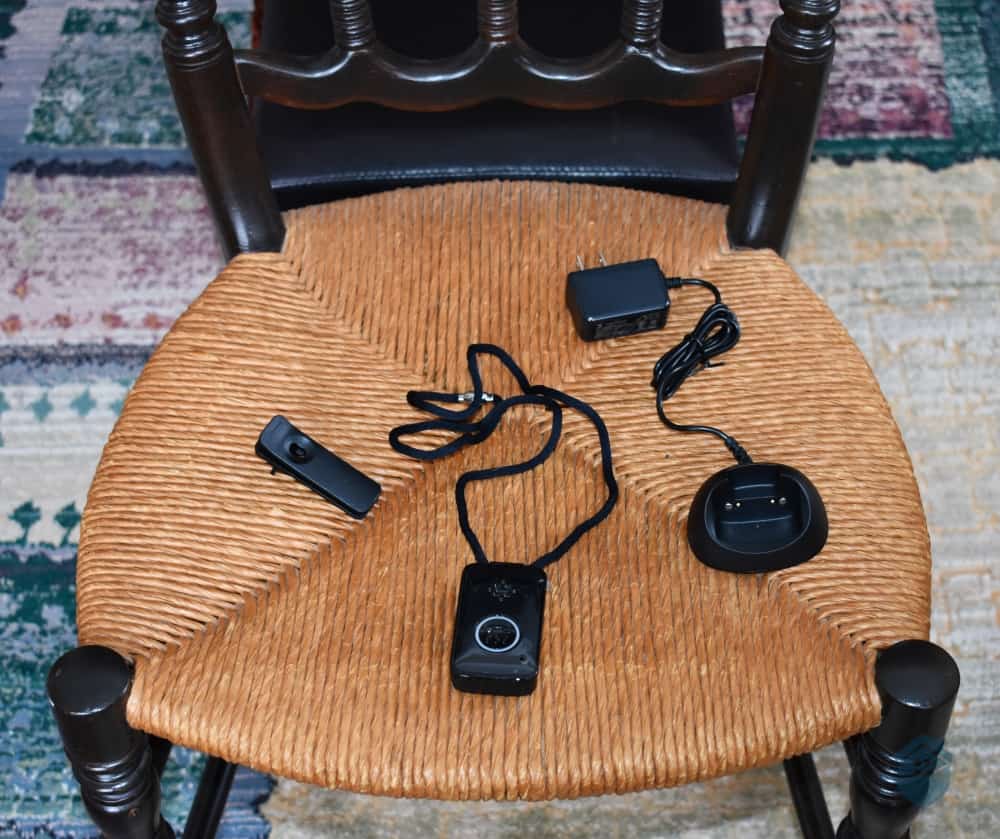
LifeFone Equipment
Like most medical alert systems, ordering can be done online. However, we strongly recommend placing your order over the phone. The reason is that LifeFone offers many options. Of course, we love having options, but in the case of LifeFone, it can get a bit confusing. This is especially true if you are trying to make a decision from the information on the website alone. We will say that LifeFone’s customer service is very knowledgeable and can walk you through the process.
Still, we should clear up a few things straight away. Let’s start with the on-the-go systems. LifeFone offers three mobile options and one bundled option, and their names are similar: At-Home & On-the-Go (the bundled system); At-Home & On-the-Go, VIP Active (which we are reviewing here); At-Home & On-the-Go, VIPx®; and At-Home & On-the-Go, Safe Watch Active®️, which is similar to the best medical alert watches we’ve looked at.
Also, know that if you order the VIP Active®️, you will use the provider’s AT&T connection. If you do not receive a strong AT&T signal in your area, you might want to consider the VIPx® which offers your choice of a Verizon or AT&T connection.
One further point of clarification一 while LifeFone’s website does state that you will receive your choice of an AT&T or Verizon connection with the VIP Active®️, the customer service agent with whom we spoke insisted that with the VIP Active®️ you only have access to the AT&T connection.
Fun Fact: In 2019, 349,344 cell towers existed in the United States.2 So you’ll be covered by LifeFone’s monitoring system pretty much anywhere you go in the U.S.
Also, remember that LifeFone does offer three different at-home alert systems. These include one system designed for landlines, one designed for cellular connections, and the at-home system included in the At-Home & On-the-Go bundle, which uses cellular connections as well.
We went with the At-Home & On-the-Go, VIP Active system, but in case you want to explore the other options, here’s a quick table highlighting their differences.
| Features | At-Home Landline | At-Home Cellular | At-Home & On-the-Go | At-Home & On-the-Go, VIP Active | At-Home & On-the-Go, VIPx | At-Home & On-the-Go, Safe Watch Active |
|---|---|---|---|---|---|---|
| Inclusions |
|
|
|
|
|
|
| Connection | Landline | Cellular | Cellular | Cellular | Cellular | Cellular |
| Fall detection | Optional | Optional | Optional | Optional | Optional | Optional |
| Power source | Plugged in | Plugged in | Plugged in | Battery | Battery | Battery |
| Battery (or battery backup) life | 32 hours (backup) | 32 hours (backup) | 30 hours (backup) | 5 days | 10 days | 24 hours |
| Starting monthly price | $24.95 | $30.95 | $36.95 | $39.95 | $41.95 | $45.95 |
When choosing the right LifeFone system for you or your aging loved one, we recommend choosing based on lifestyle. For seniors who spend most of their time at home, we recommend the At-Home systems because they’re more affordable than the At-Home & On-the-Go systems. For folks who want to stay more active and independent, on the other hand, investing more for the At-Home & On-the-Go systems is the right move.
The budget is also to be considered, especially since LifeFone’s pricing is on the steeper end. And of course, the users’ preference in terms of style is another thing to take into account. The VIP and Safe Watch systems have a more trendy style and design, but they are also a bit more expensive.
For us, the At-Home & On-The-Go, VIP Active seemed to be the right choice, so we went ahead and purchased one over the phone.
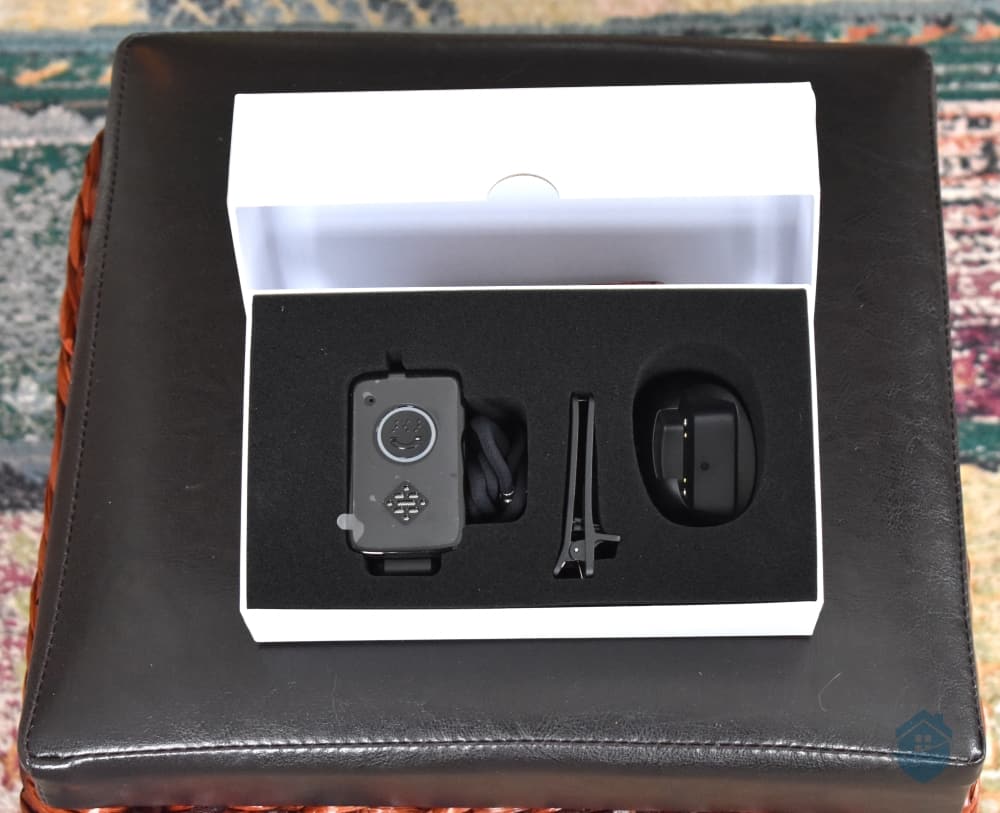
Unboxing LifeFone
This is a good time to mention that since the time we tested LifeFone, they have upgraded their lineup. The features of the At-Home & On-the-Go, VIP Active system remained the same, but the unit itself – the pendant – was replaced.
The new pendant features a slimmer, smaller and more stylish design, but because of its reduced size, it can no longer house the old unit’s battery that can last 30 days. The new pendant has a five-day battery life (or less if you activate fall detection), which is still impressive compared to the 24-hour battery life of most mobile units we’ve tested.
As for the rest of the features, you’ll still enjoy everything we’ll mention in this review. With that, let’s start!
The box that our LifeFone At-Home & On-the-Go, VIP Active®️ arrived in was about the size of a box of chocolates. (We will refrain from quoting Forrest Gump.) When we pulled out the mobile device, one of three small, simple pieces, the shiny black device was small in size and quite light. We guessed that it weighed under two ounces, and Veronica, our customer service representative, later confirmed that it weighed 1.7 ounces. So we were able to wear the mobile device comfortably on a lanyard, usually forgetting that it was even there.
FYI: Another small, lightweight device with three color options and a similar monthly cost is the Mini Guardian. Learn more in our write up of the Medical Guardian brand.
We paged through the User’s Guide as we checked out the device and that’s when we discovered its somewhat kooky name: Voice-In-Pendant. Oh well, it’s not like you are going to call your medical alert device by name. And if you are that person who does, well, you can always change it to fit your fancy.
Seriously though, we like all-in-one systems and this one seemed to fit the bill. We removed the charger from the box and immediately set it up in our living room next to the computer where we spend much of our time. We sometimes need a visual reminder to help us remember to do things like charge devices.
Moving right along…
Now, we mentioned three items in the candy-sized box. The third item gave us pause. It looked like a … hair clip? Hmm … We needed to consult with the user’s guide to determine its purpose. Lo and behold it was actually a belt clip, different from belt attachments we’ve used. Still, it is nice to have wearable options.
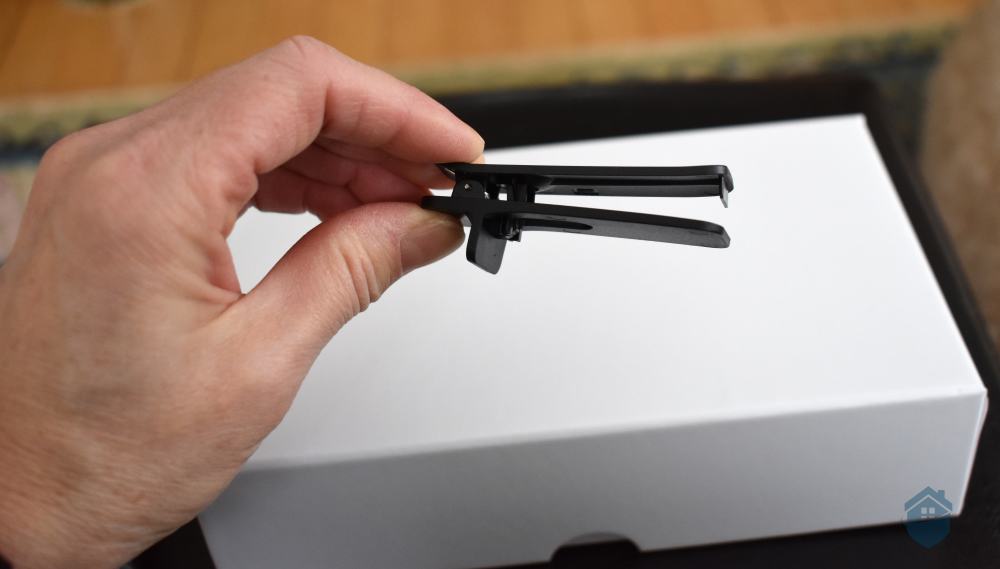
LifeFone Belt Clip
Pro Tip: For a comparison peek at a mobile device that can be attached to a belt by a well-constructed belt case (rather than a clip), read our review of Medical Alert.
Setup was pretty simple. We needed to start by charging the battery. We noticed that the ring around the device’s emergency button was not lit up when we removed it from the box. However, when we placed it on the charging cradle, the top of the ring flashed red every five seconds indicating that a charge was needed. Here, have a look…
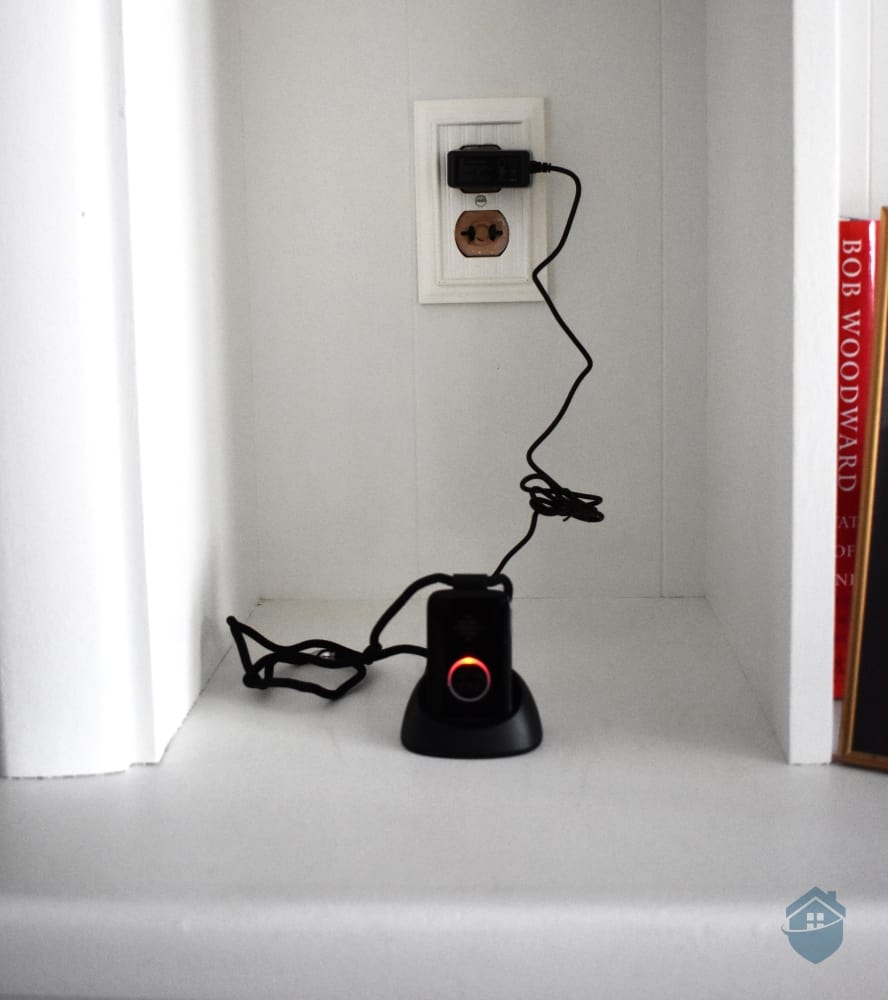
Charging LifeFone
This seems like a good time to talk about LifeFone’s battery. As we mentioned above, the battery life for the VIP Active we tested is up to 30 days, while the new one has a five-day life. Either way, that is one heck of a long battery life. You definitely will not need to charge it every day, and in fact, LifeFone advises that you charge it only when necessary. This is true for both the old and the new pendants.
We briefly wondered whether charging a device intermittently would lead to a dead device. LifeFone does put some functions in place so that this doesn’t happen.
On the old pendant, the LED light around the emergency button will flash red and vibrate when the device needs to be charged (it’s difficult to miss). Also, when you press the indicator button on the side of the device, an automated voice will indicate either “Battery ok” or “Battery low, please charge.” Pretty neat, actually. But as an extra reminder, we’re also going to keep that charger next to our computer.
On the new one, the light indicators are slightly different based on the user manual. They are on the side of the device, and the one for the battery is the red one. According to the manual, it blinks when the device needs to be charged. Another cool thing we found is that with the new pendant, LifeFone added text and email reminders when the battery begins to run low. That would definitely be a useful feature, as you won’t have to pay attention to the device to learn when to charge it.
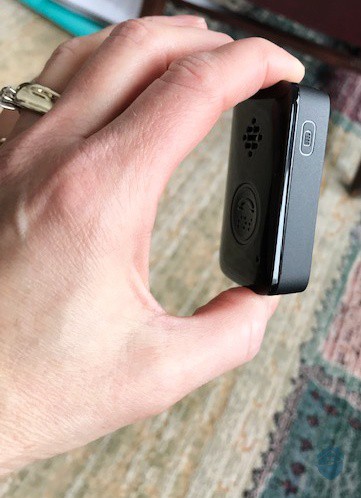
LifeFone VIP Active®️
One more point about batteries — we learned that if we had opted for fall detection on our VIP Active®️, the battery life would be cut in half. That was a disappointing discovery, at first. But when we compared the shortened battery life to that of most other brands, we realized that LifeFone was still way ahead. Most devices need to be charged daily.
A LifeFone customer care specialist we talked to also confirmed that the same is true for the new device, so it’d probably need a recharge every other day.
Did You Know? Though we have not come across other devices that have a 30-day battery life, we have seen a few with a five to seven-day battery life. For a look at another mobile device with longer-than-average battery life, read our review of LifeStation.
All right, once the red light on our Voice-In-Pendant was solid and ready for testing, we were ready to test the system. We completed the test in just a minute or two. All it takes is pressing the Emergency button and waiting for a Response Center Associate to connect. After you confirm that the call is a test, your setup is complete.
FYI: LifeFone recommends conducting a weekly test to ensure that your device is working properly.
We know you’re wondering about the best way to wear the mobile device — with a lanyard or attached to a belt. It’s really a matter of preference, but we’ll give you a few things to think about that will help you make that choice.
The Voice-in-Pendant is lightweight; it felt comfortable wearing it either way. Because LifeFone sends a lanyard and a belt clip, we experimented with both. The belt clip is not the most attractive-looking accessory we’ve seen. Looking at it another way, the device will not often be seen which is why some choose to wear it on a belt in the first place.
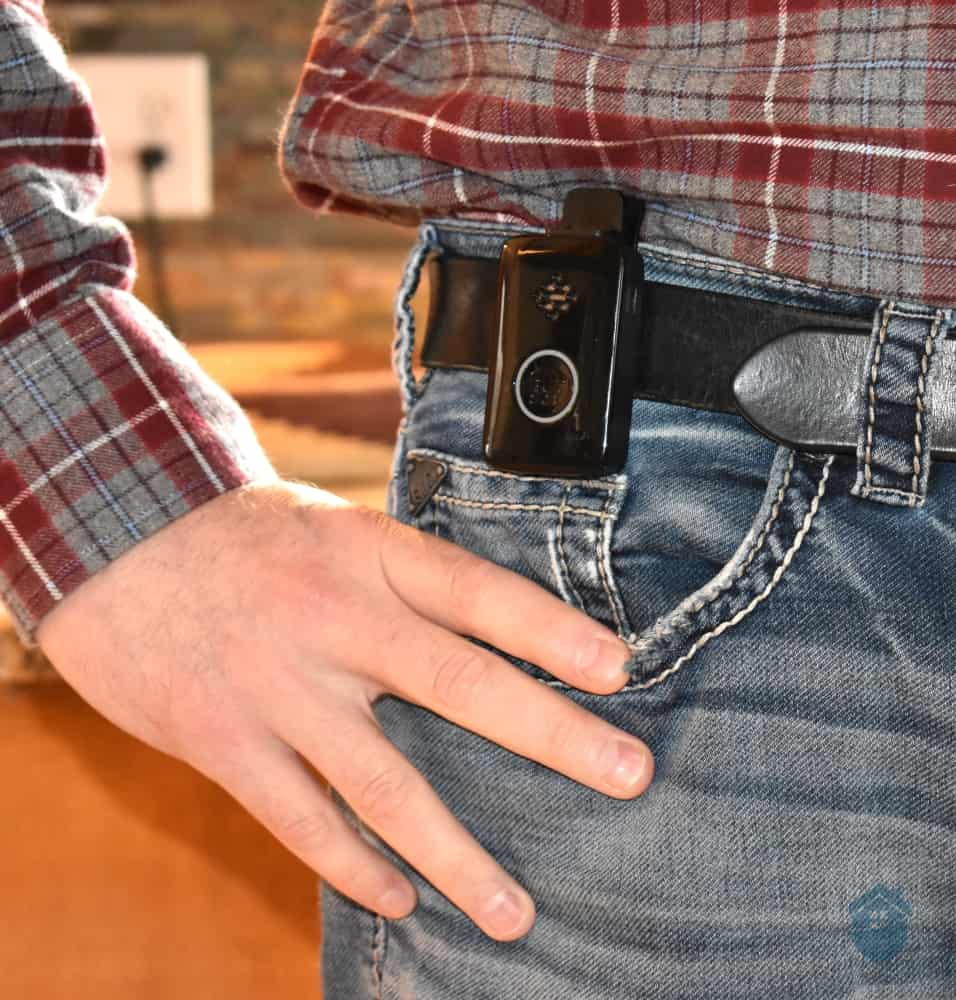
LifeFone on Belt
Often mobile devices worn on a belt come with a sturdily made case that will attach to a belt. The LifeFone belt clip seemed to have a tendency to slip around rather than remaining securely in place. We wondered if while out, and pulling a coat on and off or brushing up against something at the grocery store, the device might come loose and get lost. Again, not a deal-breaker, but something to think about.
Now let’s talk about the lanyard. Those who opt for fall detection will need to use the lanyard. On their website, LifeFone states that fall detection is not available if using the device with a belt clip.
We recommend wearing the VIP Active®️ around your neck anyway. In addition to the fact that it can be used with fall detection, it is also comfortable and relatively discreet, not to mention a bit more secure than the belt clip.
Recommended: LifeFone suggests cleaning the device weekly. This can be done by rubbing the gold contacts both on the device and the charging cradle with a soft cloth, like an eyeglass cleaning cloth.
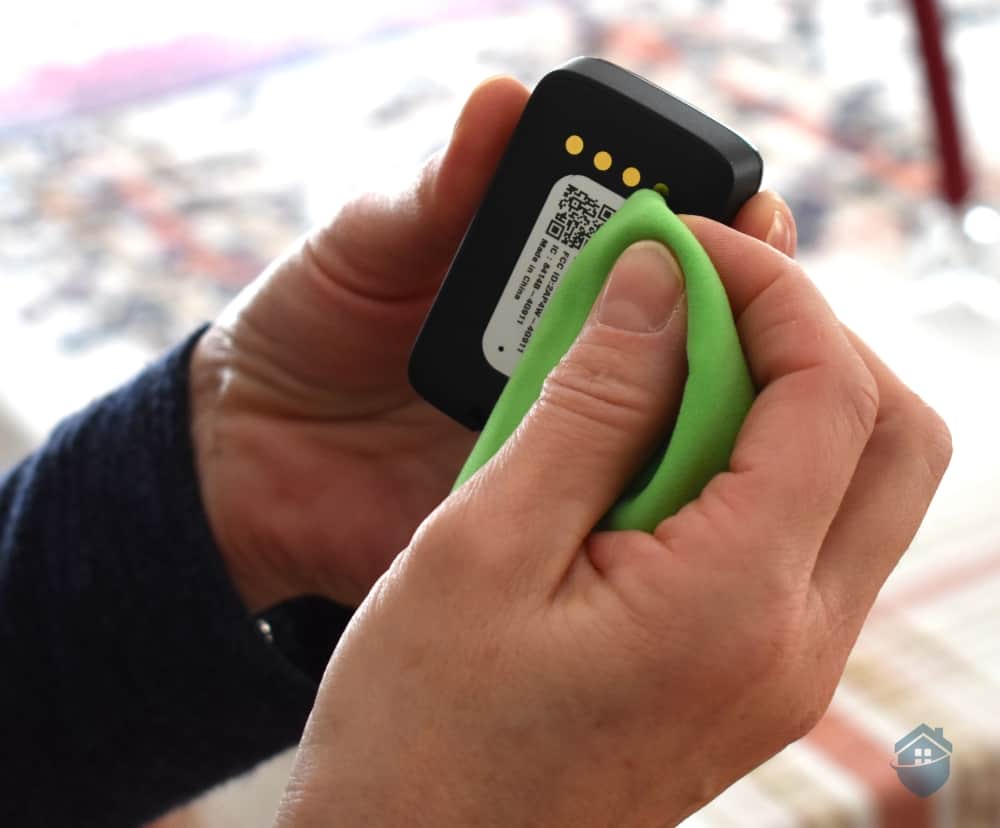
Cleaning our LifeFone device
One other thing that we should point out is the absence of any in-home help buttons with this particular system. The LifeFone VIP Active®️ could be considered a hybrid system as it has both at-home and mobile capabilities. Many other similar systems include a small, lightweight pendant with a help button that can be worn around the house.
When we asked Veronica our customer service agent about this, she explained that because it is an all-in-one system, they were keeping it a true all-in-one system. She also mentioned that with a longer battery life, an in-home help button is less necessary. All good points.
FYI: If you do want an in-home button, LifeFone offers three systems that will include it: the At-Home Landline, At-Home Cellular and At-Home & On-the-Go.
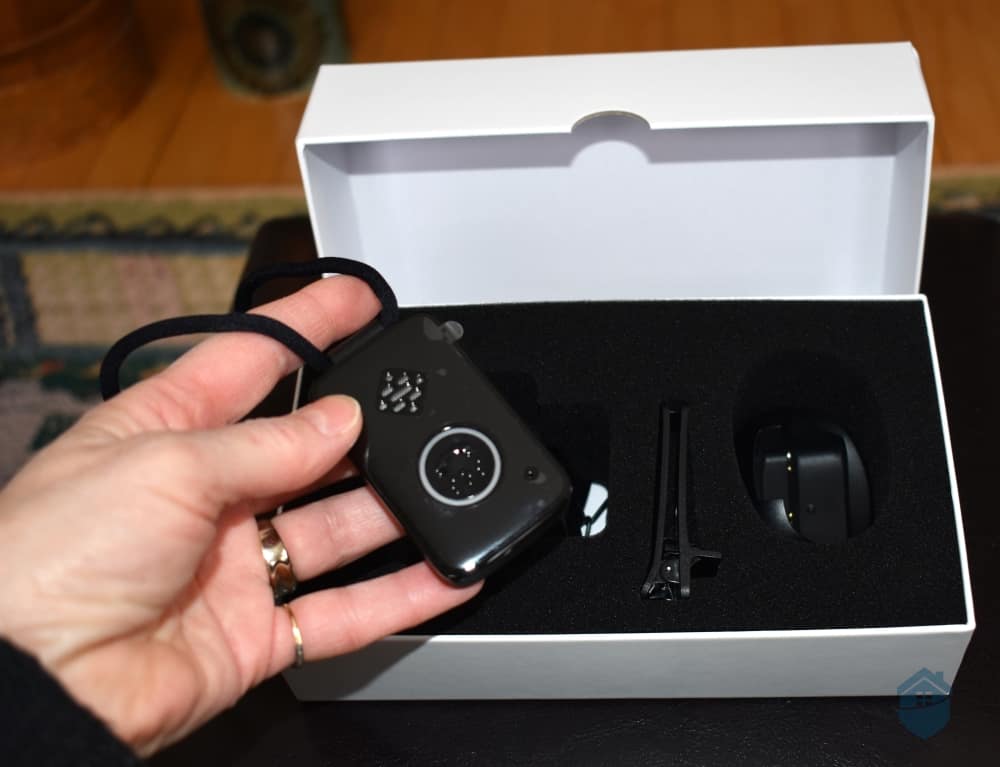
LifeFone Packaging
Also, because emergency calls can be made while the VIP Active®️ is charging, you would never really be without protection.
If interested in seeing how LifeFone compares to other mobile systems, check out our analysis of the Best Cellular Medical Alert Systems.
Finally, one of the most important things to consider is response time, which is the length of time between pressing the button for help and connecting with a response center associate.
We tested LifeFone’s system several times and during different times of the day. LifeFone’s average response time came in at a respectable 30 seconds, which also happens to be the industry average. You can definitely feel confident that a fast response is one area that LifeFone delivers on.
Here’s a quick video we made testing our LifeFone medical alert system. Check it out to get a better idea of what to expect with service and response times:
While reviewing on-the-go devices, we have found that most require a monthly charge between $35 and $50. So at $39.95 per month for the At-Home & On-the-Go, VIP Active®️, LifeFone’s price is right in line with the industry standard.
While you may find one or two cheaper monthly fees around town, we think that LifeFone’s affordability goes beyond its monthly cost. When comparing LifeFone to other mobile or dual alert systems in the same price range, we found that many other brands include additional costs. These expenses include equipment fees (as high as $300 in some cases) and installation or activation fees. LifeFone does not charge any of these extra fees. But it does have some optional add-ons which we’ll talk about next.
Pro Tip: If it’s the very best bargain that you want, we recommend reading our synopsis of the Bay Alarm Medical Alert System. We think Bay Alarm does a great job of balancing quality and price.
One thing that LifeFone will charge you for, if you opt for monthly billing, is shipping and handling. Some other companies will include this service free of charge. However, we’re guessing that a one-time charge of $15 probably won’t break the bank for most.
| LifeFone Alert System Pricing | At-Home & On-the Go | At-Home & On-the-Go, VIP Active®️ | At-Home & On-the-Go, VIPx® | At-Home & On-the-Go, SafeWatch Active® |
|---|---|---|---|---|
| Monthly Cost | $36.95 | $39.95 | $41.95 | $49.95 |
| Monthly Charge for Fall Detection | $10 (optional) | $5 (optional) | $5 (optional) | $5 (optional) |
| Equipment Fee | $0 | $0 | $0 | $0 |
| Shipping | $16.95 | $16.95 | $16.95 | $16.95 |
| LifeFone Alert System Pricing | At-Home Landline | At-Home Cellular |
|---|---|---|
| Monthly Cost | $24.95 | $30.95 |
| Monthly Charge for Fall Detection | $5 (optional) | $5 (optional) |
| Equipment Fee | $0 | $0 |
| Shipping | $16.95 | $16.95 |
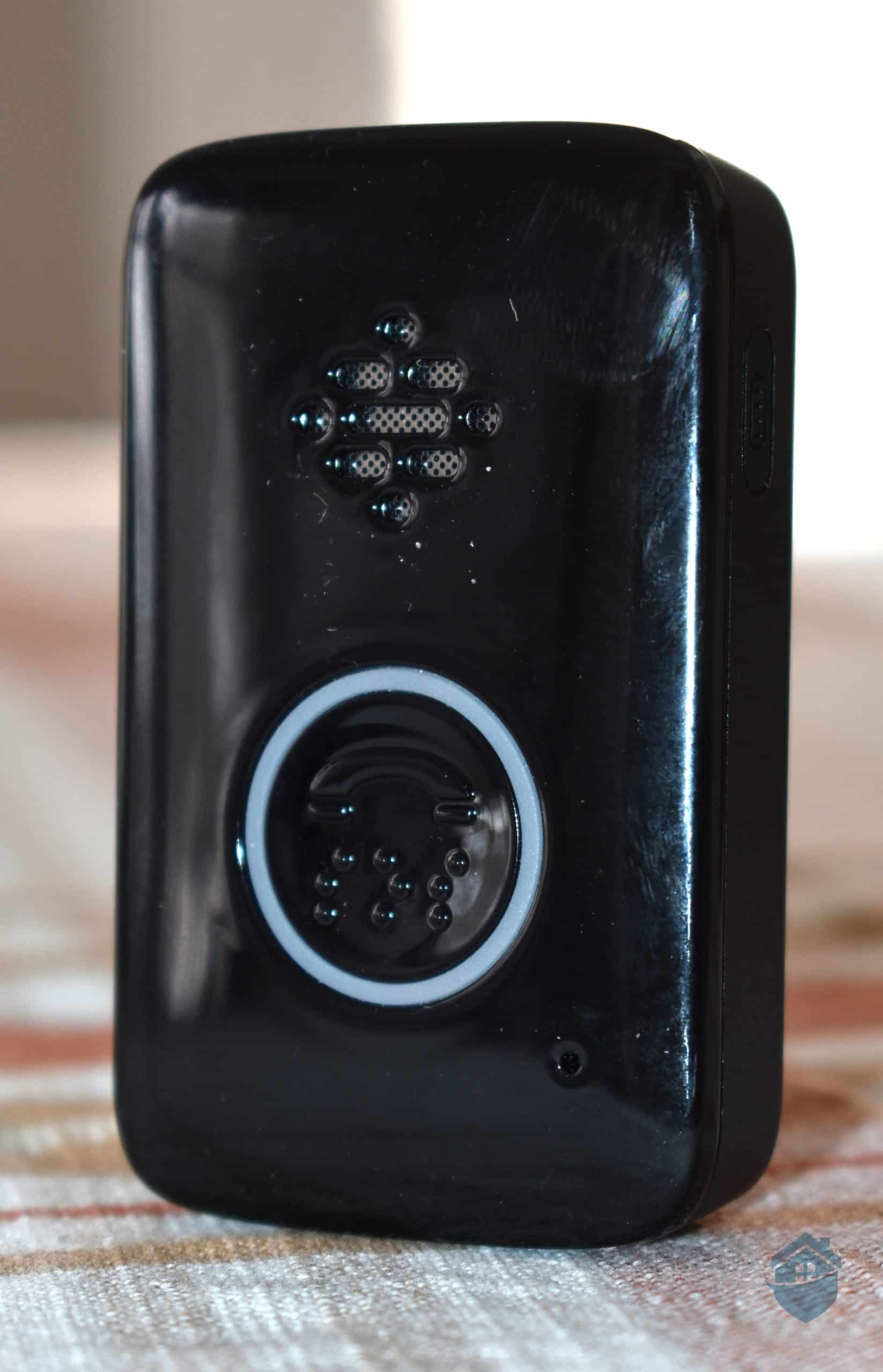
Closeup of the LifeFone VIP Active®️
Like many others in the medical alert industry, LifeFone offers several standard add-ons. Examples include several types of lock boxes; and a warranty, called the Lifefone Protection Plan.
And then there are several add-ons that are somewhat unique.
For example, the Daily Check In feature is rare, and its functionality is exceptional. It works like this. A LifeFone Care Agent will make a daily outbound call to a designated older adult. The call can be customized and registered to take place at a particular time of day. We think this feature would be especially worthwhile for older adults who live alone and whose caregiver(s) are remote. Daily Check In is offered with all five of LifeFone’s systems.
FYI: Staying in the loop through the use of technology is one of the most important steps long-distance caregivers can take, according to AARP.3
If your highest priority is finding a system that provides caregiver assistance, you will want to take a look at our review of Aloe Care Health. It enables direct location detection for caregivers plus many more beneficial features not found elsewhere.
Now, let’s talk about fall detection for a moment. Fall detection is a newish technology that is incorporated into most medical alert devices these days. (For an overview of fall detection, read our summary of the Best Medical Alert Systems with Fall Detection.)
We think it is an important feature to include in any system, home or mobile, because as people age, falls become much more common. Sometimes these falls can result in head injury. In other situations, it can be a critical medical situation that leads to the fall. For example, a stroke can lead to sudden trouble walking as well as sudden confusion or difficulty speaking.4
In either case, older adults are not always able to press a button or speak to an emergency associate, but the fall can still be detected and help summoned.
Fall detection is sometimes included in an alert system’s monthly fee, but more commonly it is added as an extra for $5 to $10 per month. The cost for fall detection with both the At-Home & On-the-Go, VIP Active®️ and VIPx® is $5 per month. Take note that with LifeFone’s bundled system, the At-Home and On-the-Go, fall detection costs $10 per month and requires the use of a separate pendant.
| Extra Feature | Price |
|---|---|
| Fall Detection | $5 per month |
| Hanging Master Lock Box | $39.95 One-Time Cost |
| Wall-Mounted Master Lock Box | $39.95 One-Time Cost |
| LifeFone Hanging Lock Box | $29.95 One-Time Cost |
| Daily Check In | $19 per month |
| LifeFone Protection | $5 per month |
All of you coupon clippers, bargain hunters and thrifters out there — you will love this. LifeFone likes to offer deals. We love getting something for nothing, so we were all over it. And we’ll even let you in on the secrets!
Ok, they are actually not secrets. LifeFone’s bargains are posted all over their website. But we have listed them below in a nutshell.
LifeFone also offers payment options that can help you save money (and get more freebies). The prices in the table above reflect the monthly cost of service. If you are willing to pay for service quarterly, the monthly price of service drops to $41.95, you will receive one free month of service for the first year and free shipping. If you opt for paying annually, the monthly price of service drops to $36.62 per month, and you will receive a free month of service the first year, free shipping and a free lockbox.
The quarterly or annual payment can be especially useful for those caregivers or older adults who have seasonal income, annual bonuses or receive tax refunds. It can also be useful for those individuals who have difficulty keeping up with monthly bills, perhaps someone with dementia.5
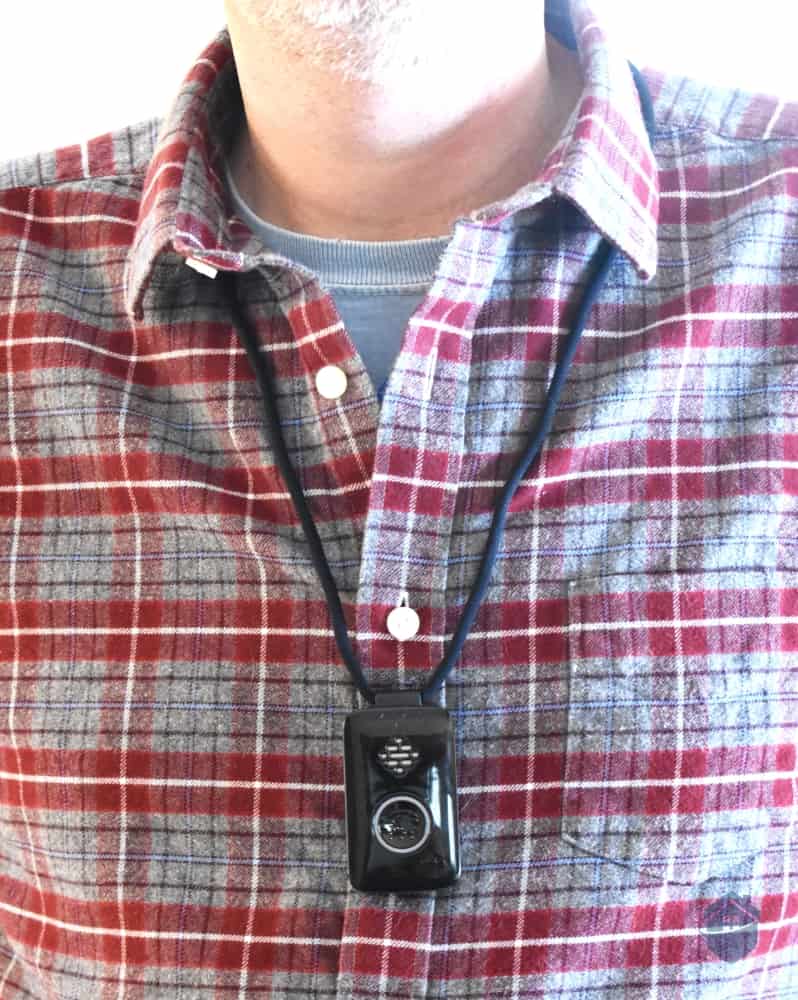
Wearing LifeFone
The two things we loved the most about the At-Home & On-the-Go, VIP Active®️ are the extensive battery life and the small size and weight of the device. At 1.7 ounces, the device is impressive and one of the lightest that we have seen. A few ounces can really make a difference when wearing something around your neck all day.
And, this all-in-one-system is really that — all in one. We think this makes sense.
LifeFone has a pretty decent response time, too! We had an agent on the line within 30 seconds, which really helps to instill confidence in the product.
We do think a few improvements could go a long way. A sturdy and better-looking belt case for the device would be nice. Also, the monthly price of the system is not the least expensive around — especially if you go wild with the extras. But we remind you that you will not need to worry about any upfront expenses. Overall, we do think that you will be getting your money’s worth here.
And remember, if you or your loved one spends a lot of time at home, we think it’s worth looking into LifeFone’s At-Home Landline and At-Home Cellular options.
Yes. For example, if you request that a caregiver be called before Emergency Medical Services, LifeFone will happily comply.
LifeFone will assist in other types of situations such as a fire or home intrusion.
The Voice-In-Pendant is 2.6” x 1.57” x .67” and weighs 1.7 ounces.
The device can be used in the shower but it should not be submerged in water.
Good question. The Lifetime Subscriber Equipment Guarantee offers a free replacement of equipment for regular wear and tear. Some older adults, like the person with dementia who loses things frequently, may want to invest in the protection plan to cover the cost of equipment in case of loss, theft, or damage.
No, you will not need to sign a contract with LifeFone. You can cancel service at any time without penalty. You will be asked to sign a service agreement that states the terms of service and requests information such as your emergency contacts, etc.
Lifefone.com. (2019.) Convince a Loved One.
https://www.lifefone.com/convince-a-loved-one.html
Celltowerleaseexperts.com. (2020, September 23). A Graphic Overview of the Cell Tower Lease Industry.
https://www.celltowerleaseexperts.com/cell-tower-lease-news/cell-tower-industry-facts-figures-2016/
AARP.org. (2020, May 15). Long-Distance Caregiving: 5 Key Steps to Providing Care From Afar.
https://www.aarp.org/caregiving/basics/info-2019/long-distance-care.htm
American Stroke Association. (2021). Stroke Symptoms.
https://www.stroke.org/en/about-stroke/stroke-symptoms
Blog.swbc.com. (2017, February 15). Monthly or Annual Auto Insurance Premium: Which is Best for You?
https://blog.swbc.com/personalhub/monthly-or-annual-auto-insurance-premium-which-is-best-for-you